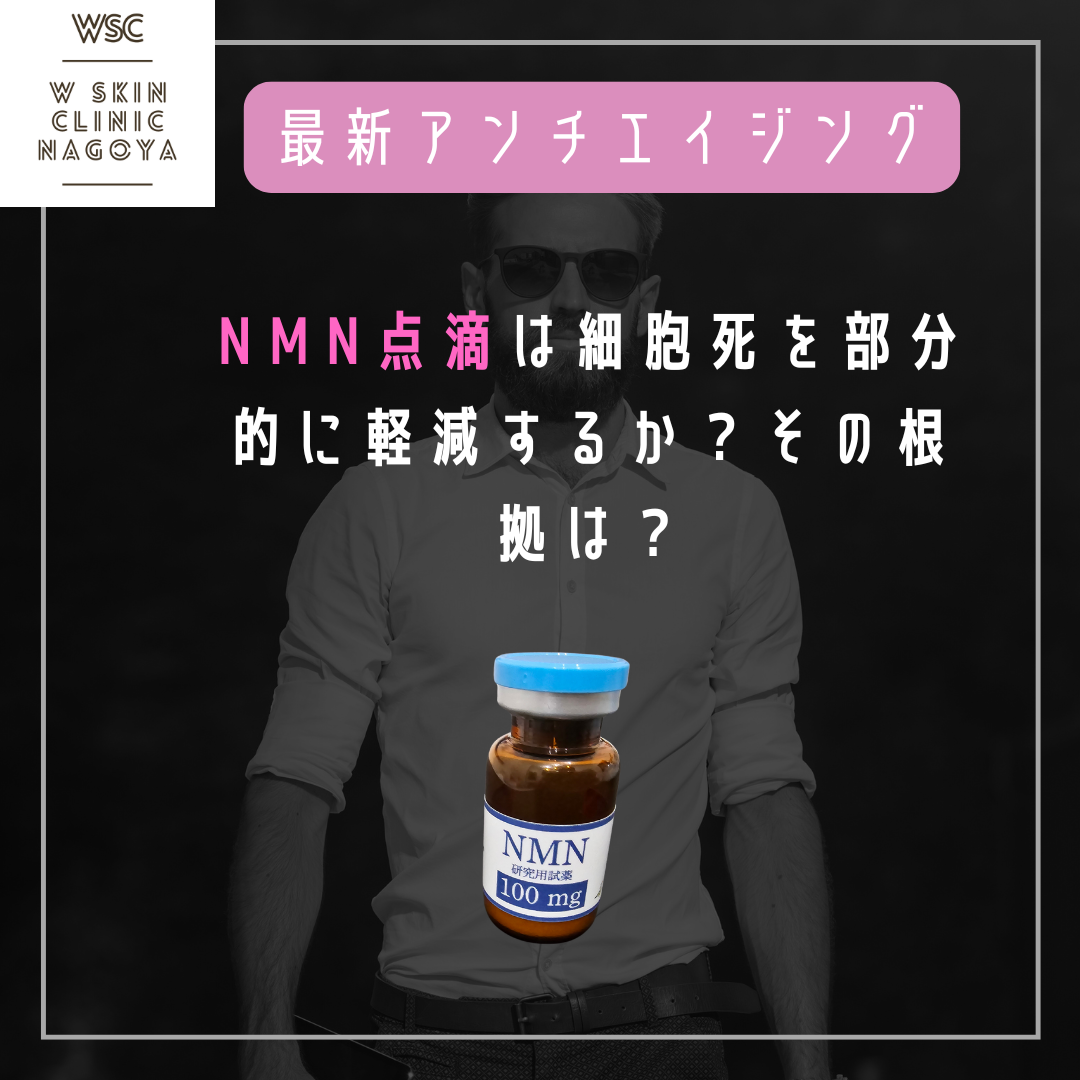NEWSお知らせ
2025.02.11|ブログ
NMN点滴は細胞死を部分的に軽減するか?その根拠は?名古屋の美容皮膚科医が解説

NMN点滴は細胞死を部分的に軽減するか?その根拠は?名古屋の美容皮膚科医が解説
こんにちは、Wスキンクリニック名古屋、院長の加藤晃司です。
今回は、NMN点滴は細胞死を部分的に軽減するか?その根拠は?について解説します。
NMN点滴と細胞死軽減の可能性について
NMN(ニコチンアミドモノヌクレオチド)は、NAD⁺(ニコチンアミドアデニンジヌクレオチド)の前駆体として知られ、細胞エネルギーの生産やDNA修復、抗老化作用に関与する重要な分子です。近年、NMN点滴が抗老化や細胞機能改善の目的で注目されていますが、細胞死(アポトーシスやネクローシス)を部分的に軽減する可能性についても研究が進んでいます。
以下に、NMN点滴が細胞死を軽減する可能性とその根拠について詳しく説明します。
- 細胞死とNAD⁺の関係
NAD⁺の役割:
NAD⁺は、細胞のエネルギー生産(ミトコンドリアでのATP生成)やDNA修復、酸化ストレス防御、炎症反応の抑制に不可欠です。
細胞死(特にアポトーシス)は、NAD⁺の枯渇やミトコンドリア機能障害によって引き起こされる場合があります。
NAD⁺の減少:
加齢やストレス、炎症によってNAD⁺レベルが低下すると、細胞のエネルギー代謝が破綻し、細胞死が促進されます。
- NMNが細胞死を軽減するメカニズム
(1)NAD⁺の供給増加
NMNはNAD⁺の前駆体:
NMN点滴は、NAD⁺のレベルを直接補充する手段として機能します。
NAD⁺レベルが回復することで、ミトコンドリアの正常な機能が維持され、エネルギー供給が安定するため、細胞死が抑制される可能性があります。
(2)サーチュイン経路の活性化
サーチュイン(SIRT)酵素群:
NAD⁺はサーチュイン酵素の活性化に必要不可欠です。これらの酵素は、DNA修復や細胞保護に関与します。
サーチュイン活性化によって、酸化ストレスやDNA損傷が軽減され、アポトーシスが抑制される可能性があります。
(3)酸化ストレスの軽減
ROS(活性酸素種)の抑制:
NAD⁺は、抗酸化酵素の活性化に寄与し、活性酸素種(ROS)を抑制します。
ROSは細胞死を引き起こす主要な要因であり、NMNによるNAD⁺補充がこれを緩和します。
(4)炎症の抑制
PARPの過剰活性抑制:
DNA損傷が発生すると、PARP(ポリADPリボースポリメラーゼ)という酵素がNAD⁺を大量に消費します。
NMNがNAD⁺レベルを補充することで、PARP過剰活性化によるエネルギー消耗を防ぎ、細胞死を軽減する可能性があります。
(5)ミトコンドリア機能の改善
ミトコンドリアの保護:
NAD⁺が十分に供給されると、ミトコンドリア内のエネルギー代謝が正常化し、ミトコンドリア誘導性のアポトーシスが抑制される可能性があります。
- NMNの効果を裏付ける研究データ
(1)動物モデルでの研究
加齢性疾患における効果:
マウス研究では、NMN投与によってNAD⁺レベルが回復し、加齢に伴う組織の機能低下や細胞死が軽減されたことが報告されています。
脳神経細胞の保護:
NMNが脳の神経細胞を保護し、酸化ストレスによるアポトーシスを減少させることが示されています。
筋肉や肝臓への効果:
筋肉や肝臓での細胞死が減少し、組織再生が促進された報告があります。
(2)ヒトでの研究
臨床試験(初期段階):
ヒトでの臨床試験でも、NMNの投与がNAD⁺レベルを上昇させ、エネルギー代謝や抗酸化機能の改善に寄与することが示唆されています。
直接的な細胞死軽減効果のデータはまだ限定的ですが、間接的な細胞保護効果が期待されています。
まとめ
NMN点滴は、細胞死を部分的に軽減する可能性があると考えられています。特に、NAD⁺の補充を通じて細胞のエネルギー代謝を正常化し、酸化ストレスや炎症による細胞死を抑制するメカニズムが提唱されています。
アンチエイジングは少しでも早くスタートした方が効果的です。
アンチエイジング点滴としては、エクソソーム、NMN、高濃度ビタミンC、グルタチオン、をご用意しています。
私はこれらの点滴をすべて定期的に行っています。
一緒にアンチエイジングしていきましょう。
Wスキンクリニック名古屋でのエクソソーム治療はこちら
https://www.w-clinic-nagoya.com/acne/exosome
NMN点滴はこちら
https://www.w-clinic-nagoya.com/beauty-drip/nmn
高濃度ビタミンC点滴はこちら
https://www.w-clinic-nagoya.com/beauty-drip/vitamin-c
*当院では
NMNは一般社団法人NMN医療研究会、エクソソームはセルソース株式会社のM2P-エクソソームを使用しています。
当院では無料でスタッフカウンセリングを行なっております。
お気軽にご予約くださいませ
Wスキンクリニック名古屋 (美容皮膚科)
https://www.w-clinic-nagoya.com/
〒461-0005 愛知県名古屋市東区東桜 2-4-1 第3コジマビル6F
TEL 052-7377-7117(10:00~19:00)
LINE ID @w.nagoya
高岳駅より徒歩4分 / 新栄町駅より徒歩5分
お車でお越しの方
名鉄協商パーキングチケットをお渡しいたしますので、クリニック近くのパーキングをご利用ください。
ご予約、お問合せ、Wスキンクリニック名古屋公式LINEからも可能です。
LINE ID : @w.nagoya
友達追加は↓から
Wスキンクリニック名古屋公式インスタ↓
https://www.instagram.com/w.skinclinic.nagoya?igsh=NHhoODFnaXB2b2ll&utm_source=qr
Wスキンクリニック院長 加藤晃司インスタ↓
https://www.instagram.com/w.skin.nagoya.kojikato?igsh=aW9nbWZwNjNjZ3pz&utm_source=qr
Can NMN IV Therapy Partially Reduce Cell Death? What is the Scientific Basis?
Explained by a Cosmetic Dermatologist in Nagoya
Hello, I’m Dr. Koji Kato, the director of W Skin Clinic Nagoya.
Today, I will discuss whether NMN IV therapy can partially reduce cell death and the scientific basis behind this potential effect.
- Understanding NMN and Its Role in Cell Health
What is NMN?
NMN (Nicotinamide Mononucleotide) is a precursor to NAD⁺ (Nicotinamide Adenine Dinucleotide), a crucial molecule involved in cellular energy production, DNA repair, and anti-aging mechanisms.
Aging, stress, and inflammation lead to a decline in NAD⁺ levels, which can result in cellular dysfunction and increased cell death (apoptosis or necrosis). NMN IV therapy is believed to restore NAD⁺ levels, potentially mitigating some of these harmful effects.
- How NMN May Reduce Cell Death
(1) Restoring NAD⁺ Levels to Maintain Cellular Energy
NAD⁺ is essential for ATP production in mitochondria, which provides energy for cellular processes.
A drop in NAD⁺ can lead to energy depletion, increasing the likelihood of apoptosis (programmed cell death).
By boosting NAD⁺ through NMN IV therapy, cells can maintain their metabolic functions, reducing the risk of premature cell death.
(2) Activation of Sirtuin Pathways for Cellular Protection
Sirtuins (SIRT1–SIRT7) are longevity-related enzymes that require NAD⁺ to function.
Sirtuins play a key role in DNA repair, inflammation control, and stress resistance, helping cells survive under oxidative stress conditions.
NMN supplementation has been shown in studies to enhance sirtuin activity, thereby promoting cell survival.
(3) Reduction of Oxidative Stress
Oxidative stress (caused by reactive oxygen species, ROS) damages cells and contributes to aging and cell death.
NAD⁺ is a coenzyme for antioxidant defense mechanisms, such as those involving superoxide dismutase (SOD) and catalase.
NMN-induced NAD⁺ replenishment may enhance these antioxidant defenses, preventing oxidative damage and reducing apoptosis.
(4) Inhibition of PARP Overactivation to Preserve NAD⁺
Poly (ADP-ribose) polymerase (PARP) is activated when DNA damage occurs and consumes large amounts of NAD⁺ to repair DNA.
Excessive PARP activation can deplete NAD⁺, leading to energy failure and cell death.
NMN therapy helps restore NAD⁺ levels, preventing excessive depletion and protecting cells from death.
(5) Supporting Mitochondrial Function
Mitochondrial dysfunction is a key trigger of cell death in aging and disease.
NAD⁺ plays a vital role in mitochondrial function, and its depletion leads to mitochondrial-induced apoptosis.
NMN therapy has been shown to restore mitochondrial health, thereby reducing cell death in studies on aging and neurodegeneration.
- Scientific Evidence Supporting NMN’s Protective Effects
(1) Animal Studies
Aging-related cell death reduction:
Studies on aged mice show that NMN supplementation restores NAD⁺ levels, improving tissue function and reducing cell loss in organs such as the liver, muscles, and brain.
Neuroprotection:
NMN has been shown to protect brain neurons from oxidative stress-induced apoptosis, suggesting potential benefits for neurodegenerative conditions.
Improvement in muscle and liver regeneration:
Research indicates that NMN therapy reduces apoptosis and promotes regenerative processes in muscles and the liver.
(2) Human Studies
Clinical trials on NMN therapy in humans have shown improved NAD⁺ levels and enhanced metabolic functions, although direct evidence for reducing cell death in humans remains limited.
Early-phase clinical studies suggest that NMN supports tissue regeneration and delays age-related decline, but further large-scale studies are needed.
- Summary: Can NMN IV Therapy Reduce Cell Death?
NMN IV therapy may partially reduce cell death by:
✔ Restoring NAD⁺ levels to maintain cellular energy.
✔ Activating sirtuin pathways for DNA repair and cell survival.
✔ Reducing oxidative stress, preventing mitochondrial dysfunction.
✔ Regulating PARP activity to prevent excessive NAD⁺ depletion.
✔ Enhancing mitochondrial function, promoting healthy cell metabolism.
While preclinical studies in animals strongly support these effects, human studies are still in their early stages. However, the potential benefits of cell protection and anti-aging make NMN IV therapy a promising option for those seeking to optimize longevity and overall health.
At W Skin Clinic Nagoya, we offer NMN IV therapy, Exosome therapy, High-dose Vitamin C, and Glutathione drips as part of our advanced anti-aging treatments.
I personally receive these infusions regularly to combat cellular aging and maintain optimal health.
Let’s work together to slow down aging and protect our cells! 🚀




